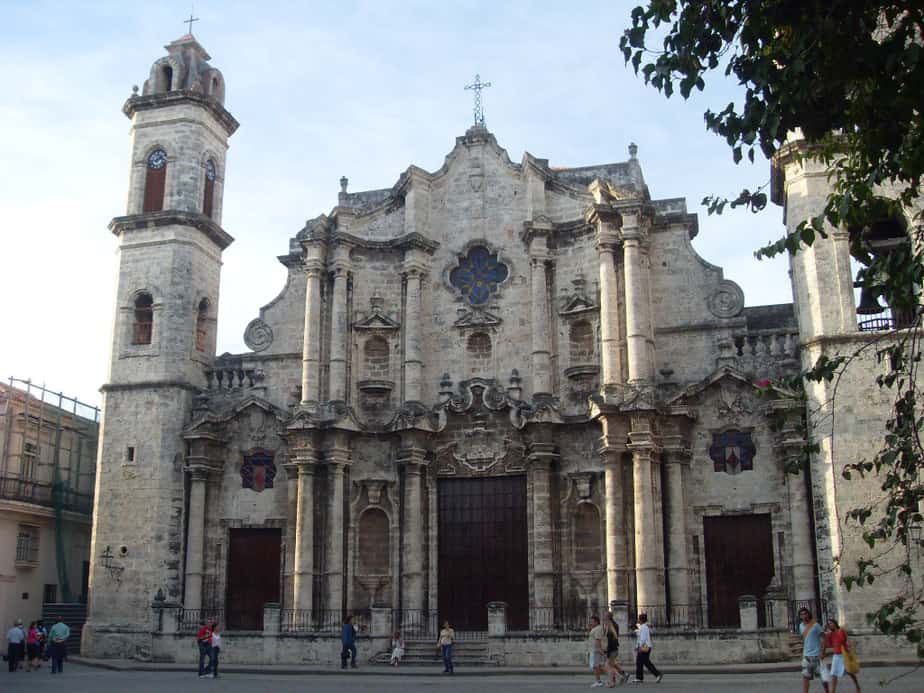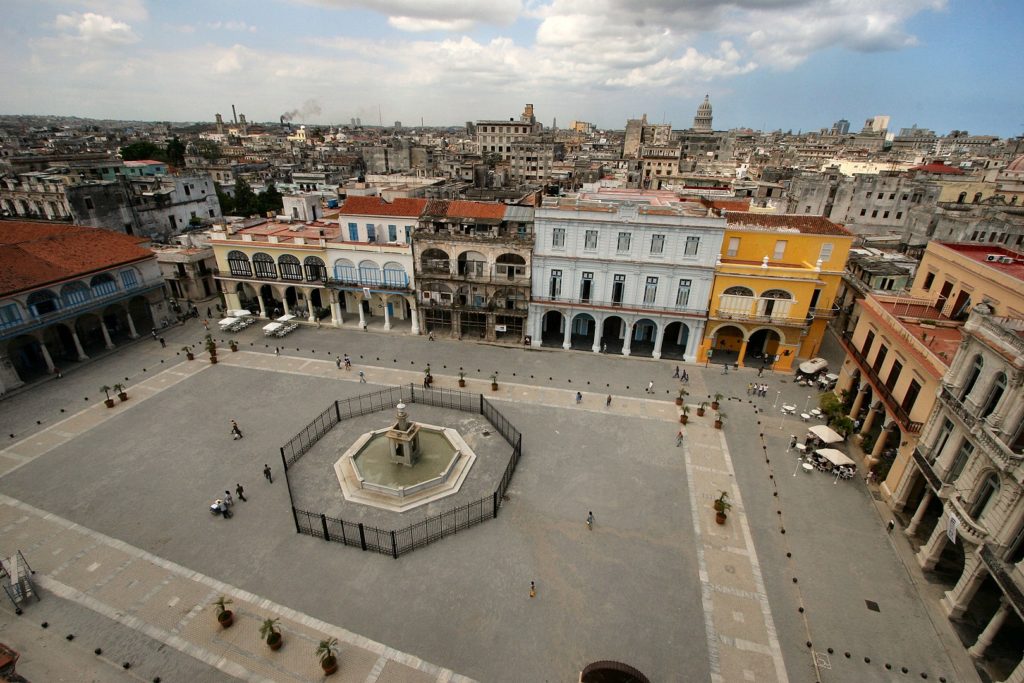
By Wicki – Wikimedia
Top 15 Facts about Old Havana in Cuba
*Originally published by Lilian on May 2021 and Updated by Vanessa R on May 2023
This city was founded in southern Cuba in 1514 but was moved to its current location next to what was called Puerto de Carenas. Old Havana was a busy trading port because of its natural bay.
It makes up one of the 15 municipalities in Havana. This is the second-highest populated city and is the core of Havana. Its walls are the current boundaries of Old Havana.
Havana is so full of life, colourful, bright and always graced with sunshine. All these good vibes are courtesy of the locals who are warm and friendly.
The other side of Old Havana is it is laid back and has so much to offer, historical buildings, street performers and charming streets.
Here are the top facts about Old Havana.
1. It more than 500 years old

By Wilder Mendez – Wikimedia
Havana was founded by the Spanish in November 1519 along the natural harbour of the Bay of Havana. The Spanish would stop here whenever they travelled between the New World and the Old World.
It became a shipbuilding centre in the 17th century. This led to the construction of baroque and neoclassical styled buildings.
Unfortunately, most of the buildings got ruined in the 20th century. Some of the buildings have been restored. There are several buildings along the quaint narrow streets in Old Havana.
It is approximated that there are about 3,000 buildings in this part of town. The official centre of Old Havana is Plaza de Armas.
Different types of people passed through Old Havana such as explorers, entertainers, indigenous people and buccaneers.
2. The architecture in Old Havana is similar to that in Spain
Old Havana bears a resemblance to Cadiz and Tenerife in Spain. This is because the Spanish used the same architectural designs like those found in Spain.
These buildings were referred to as the columns since it has some ancient monuments, forts, convents, palaces and churches. The alleys and arcades are quite serene too.
The Cuban government has done extensive work in preserving and restoring the city. The renovation fully transformed Old Havana into a tourist attraction. This city is also known as Old Havana’s de facto Mayor.
3. The city is a UNESCO Heritage site

By Wicki – Wikimedia
Old Havana is a UNESCO World Heritage site. The city is defined by its Rumba riffs, quaint cobbled squares and streets, vintage cars, historic forts, museums, and beautifully restored architectural gems.
This historical city is accessible by foot and has several tourist attractions and colourful old buildings. The narrow lanes are picturesque, walking through them while mingling with the locals.
There are coffee shops at the plazas where the Cuban Baroque style meets Art Nouveau.
4. The French army burnt the city but the Spanish rebuilt it
In 1555, Old Havana was destroyed by Frenchman known as corsair Jacques de Sores. He had taken over the city by overpowering the defenders.
Jacques destroyed the city and burnt it down to the ground. He, unfortunately, did not get any treasures he hoped he would get before plundering.
He was overpowered and thrown away. The Spanish army was brought in to rebuild the city walls and protect them.
Construction of Castillo de la Real Fuerza began in 1558. This was the first fortress built and was supervised by engineer Bartolomé Sanchez.
Most of the buildings here are of baroque and neoclassical architectural designs. Its official centre is the Plaza de Armas.
5. Culture in Havana is diverse

By Emmanuel Huybrechts – Wikimedia
Havana is a hub of a rich and diverse cultural environment. It is made up of the Spanish, Europeans, Africans and other native Indian tribes.
The original native Indian tribe that lived here was displaced during the first contact with the Spanish. Following the colonial years, a huge number of black slaves were brought from Africa.
After abolishing slavery in the 19th century, they moved to Havana where they mixed with White Spanish, Black ethnic groups, and the mulatto strains.
There is a park in Old Havana that is named in honour of John Lennon. Fidel Castro was a big fan of the Beatles, he also ensured that there is a life-size statue sitting on a bench in the park.
The statue’s glasses were stolen by vandals several times so that the management opted to not have them replaced.
6. There used to be walls that protected the city from invaders
After Jacques’s ruined the city, the Spanish brought their armies to repair the city. One addition to the city was the construction of walls to protect it from invaders.
As the city grew, the borders of Old Havan extended beyond the original walls. Since the southern and eastern were already stretched, the city was later expanded to the east through the construction of tunnels.
This led to the development of suburbs like La Habana del Este. There are other several broad avenues and boulevards across the city.
The Malecon is a beautiful boulevard that stretches to the southwest along the port entrance of Almendares river. The tunnel under the port connects to Miramar.
7. The city has beautiful historic buildings

By Libby norman – Wikimedia
The modern Havana is divided into three cities: Old Havana, Vedado, and the newer suburban districts.
Old Havana, just as its name suggests, is characterised by narrow streets and overhanging balconies. It was the traditional business central district where most of the city’s commerce and entertainment activities took place.
The city has residential areas too. Most of the buildings are historic and a true representation of the 16th and 19th architectural designs.
Old Havana covers 3 square miles not to add the harbour. The Spanish colonial structures, baroque churches and neoclassical styled buildings.
This part of the city is known for its lush parks and cobbled plazas. The locals love to hang out at Habanero, because of its trees and green spaces.
8. Vedado attracted many American tourists
Close to Old Havana is Vedado. Most of the buildings here were built in the 20th century. They are beautiful and attractive homes, modern tall apartments.
This part of the city is defined by modern office parks, wide avenues and tree-lined boulevards. There are several hotels in this part of town from luxury hotels to boutique hotels.
Several American tourists loved to frequent this part of town in the 1950s. It is also known as central Havana and it makes up the shopping district of Havana.
Some top attractions in this part of town are the Colon cemetery named after the explorer Christopher Columbus.
9. Plaza Vieja was used for military exercises

By Brian Snelson – Wikimedia
Plaza Vieja in Old Havana is a historical location. Several incarnations have taken place in this part of town. It is one of the most popular spots in Havana that attracts both locals and tourists.
The foundation of the Square was laid in the 16th century and was used for military exercises. It was later turned into a market place.
As the city developed fast and soon the plaza was turned into an underground car park. Havana’s people and the government worked on restoring the square, turning it into the popular gathering spot it is today.
There is a mix of both historical and baroque styled buildings. The square has a small 18th-century fountain. The highlight of this Square is the 18th century Casa del Conde Jaruco.
10. Callejon de Hamel has beautiful murals
For beautiful life-size murals, Callejon de Hamel is where to go. The homes and shops here have grand-sized murals on their walls.
On Sundays, you will find dancers from the Santeria faith dancing to rumba rhythms. For a true sense of Afro-Cuban culture, this alley is the place to go to. There are several cafés and shops selling art as well as live music sessions.
11. It was once briefly a British territory
Havana was formerly a Spanish colony, although it is today completely Cuban. Did you know that Havana was once a British colony for a brief period of time? It’s one of the city’s lesser-known facts.
The British seized Havana in June 1762 during the Seven Years’ War (1754–1763), which was mostly fought between France, Spain, and Britain. They only held it for a little over a year before selling it back to the Spanish in exchange for their possession of present-day Spanish lands in Florida.
It’s strange to consider that Cuba could have easily joined the British Commonwealth.
12. Pirates used to be a real threat in this area
The city’s violent past is one of the most interesting aspects of Havana. In addition to the many invasion attempts by other nations, there were also a good number of pirate attacks on the city. Disney films using the characters from The Pirates of the Caribbean may just be fictional today, but at one time there was a real danger posed by these pirates.
Unbelievably intimidating fortifications were built to protect the city from pirates and hostile foreign armies.
Perched over the harbour in Havana, the Castillo de la Real Fuerza is a massive site to see. It was completed in 1577 and has defended the city endless times.
13. It’s known as the City of Columns

Christopher Michel, CC BY 2.0, via Wikimedia Commons
Different cities are known for different things. Los Angeles is known as City of Angels. Paris is the City of Lights. Some cities were given rather distasteful nicknames cities like Edinburgh are known as “Auld Reekie” (Old Reeky) because of all the smoke.
Ciudad de las Columnas, or the City of Columns, is a really lovely nickname for Havana. Walking around Havana and observing the beautiful colonial architecture—which does, in fact, have a lot of (beautiful) columns make this name make sense.
14. A hot air balloonist went up and disappeared
Take a moment to reflect on one of the oddest facts about Havana as you visit Park Central in the city. Matias Perez then ascended to the skies from this location and vanished forever.
Perez flew in a hot air balloon just once before taking off on his second voyage (and final). On June 29, 1856, it was very windy.
By the time it was seven o’clock, Perez had made up his mind to wait till the wind had died down. He was obviously not right! Perez disappeared when his balloon rose into the air.
15. The Bacardi’s left the city and their beautiful building

Takethemud, CC BY-SA 3.0, via Wikimedia Commons
The old Bacardi Building in Havana is among the city’s most stunning structures. The reason we say “former” is because the Bacardi family left Havana after the Cuban Revolution, taking their rum manufacturing operations with them.
A bell tower can be seen at the top of this incredibly beautiful art deco structure, which was finished in 1930. Following the revolution, the government seized private businesses (and assets), so the Bacardi family quickly left the city, leaving their lovely building behind.
Its new use (as government offices) was a little less exciting, but wouldn’t it be fantastic to work somewhere so lovely?
Planning a trip to Paris ? Get ready !
These are Amazon’s best-selling travel products that you may need for coming to Paris.
Bookstore
- The best travel book : Rick Steves – Paris 2023 – Learn more here
- Fodor’s Paris 2024 – Learn more here
Travel Gear
- Venture Pal Lightweight Backpack – Learn more here
- Samsonite Winfield 2 28″ Luggage – Learn more here
- Swig Savvy’s Stainless Steel Insulated Water Bottle – Learn more here
Check Amazon’s best-seller list for the most popular travel accessories. We sometimes read this list just to find out what new travel products people are buying.










